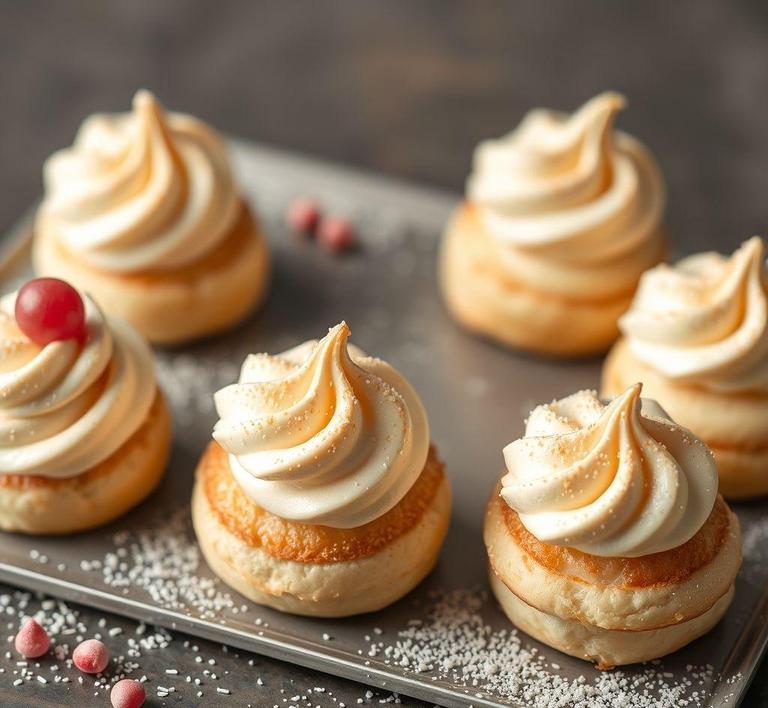Refreezing puff pastries can be a bit tricky, but with the right techniques, you can keep them fresh for later use without sacrificing their flakiness and flavor. Whether you’ve made a batch at home or have store-bought pastries, understanding how to properly refreeze them is key to preserving that delicate texture. In this guide, we’ll walk you through the best methods for refreezing puff pastries, including tips on storing them, how to prevent sogginess, and what to expect when you reheat them. With just a few simple steps, you’ll be able to enjoy these buttery, golden treats whenever you like!
Can You Refreeze Puff Pastries?

Puff pastry is a delicate, flaky dough made from layers of butter and flour that create its characteristic texture when baked. Whether it’s a savory treat like cheese-filled pastries or a sweet indulgence like fruit-filled turnovers, puff pastry is a beloved ingredient in many culinary traditions.
But the question often arises: Can you refreeze puff pastries? The answer depends on a few important factors. Technically, you can refreeze puff pastries, but it comes with some caveats. The process of freezing, thawing, and refreezing dough can alter the texture, flavor, and structure of puff pastry, so it’s essential to handle it properly to avoid diminishing its quality.
How To Refreeze Puff Pastries?
If you find yourself with leftover puff pastry or want to store it for future use, here’s a step-by-step guide to ensure the best results when refreezing:
- Thaw Properly: If you’ve already frozen the puff pastry once and want to refreeze it, the key is to thaw it properly first. Do not leave the dough out at room temperature for too long, as this can make it soggy and increase the risk of bacterial growth. The best approach is to place it in the fridge overnight, where it can thaw slowly and maintain its texture.
- Handle Gently: Once thawed, handle the puff pastry as gently as possible. Puff pastry dough is very delicate, and if it’s manipulated too much, it can lose its flakiness. Keep it cold during the process, as warmth will cause the butter to soften and break down the layers.
- Freezing After Pre-baking (Optional): If you’ve already baked your puff pastry once, you can freeze it after the initial bake. This is useful for pastries like turnovers or puff pastry twists. Bake the pastries until they’re just slightly golden, then cool them completely before placing them in an airtight container or freezer-safe bag. When you’re ready to serve, simply reheat them in the oven until crispy.
- Packaging for Refreezing: Use a double-layer method for refreezing to minimize the risk of freezer burn. Place the pastries or dough on a baking sheet and freeze them individually first, then transfer them to a freezer-safe bag or airtight container. Make sure to expel as much air as possible to prevent oxidation and preserve the quality.
- Label and Date: It’s always a good idea to label the container with the date and what’s inside. While puff pastry can last a few months in the freezer, having a clear label will help ensure you use it within the best timeframe.
Quality Impact
Refreezing puff pastry comes with a few notable quality changes, which are essential to consider if you’re aiming for the best taste and texture.
- Texture Changes: Puff pastry relies heavily on its ability to puff up and form flaky layers. When frozen, thawed, and refrozen, the moisture content can affect the dough’s ability to retain its crispness and flakiness. Each cycle of freezing and thawing can cause the dough to lose some of its structure. Instead of the crisp, light, and airy layers you expect, you may get a more dense and soggy result.
- Flavor Alterations: The flavor of puff pastry is predominantly determined by the butter or fat used. When frozen and thawed repeatedly, some of the butter may separate or become absorbed into the dough, altering the taste. While this won’t necessarily make the pastries unpleasant, you may notice a slight difference in richness or freshness.
- Structural Integrity: The delicate balance of butter and dough in puff pastry can be affected by freezing. Excessive freezing and thawing can result in the loss of some of the layers, making the dough more difficult to roll out or cut cleanly. In some cases, the pastry may not puff up as much during baking.
- Moisture and Crispness: When freezing, excess moisture can form ice crystals, which, when thawed, may cause the pastry to become soggy. This is especially true if the pastry has been frozen multiple times. Moisture loss can also occur, making the pastries dry when reheated.
While it’s technically possible to refreeze puff pastries, it’s not always ideal. The process of freezing and refreezing can significantly impact the texture, flavor, and overall quality of the pastry. The light, flaky layers that make puff pastry so appealing can become less pronounced after multiple cycles of freezing and thawing. However, if done carefully and with proper handling, you can still refreeze puff pastries and enjoy them, though they may not be quite as perfect as the first time around.
For optimal results, it’s better to freeze puff pastry dough before baking, ensuring that the layers remain intact. If you’re working with already-baked puff pastries, remember to handle them gently and keep them stored properly to preserve their crispness and flavor. Lastly, always consider whether it’s worth refreezing based on how soon you’ll be consuming the pastries and whether they are best enjoyed fresh for the highest quality experience.
Is It Safe To Refreeze Puff Pastries?
Refreezing puff pastries can be a bit of a tricky business, and the answer largely depends on how the pastries were initially frozen, how they were handled, and whether they’ve already been baked or not. Generally speaking, puff pastries can be refrozen, but it’s not always the best option due to the delicate nature of the dough.
The biggest concern when refreezing puff pastries is the effect freezing and thawing have on the layers of dough. Puff pastry is made up of alternating layers of dough and butter (or other fat), which are what give the pastry its characteristic flaky, airy texture. When frozen, the water content in the dough forms ice crystals that can damage the delicate layers. Each time you thaw and refreeze, these layers can become denser and less distinct, which leads to a loss of the crispy, light texture we love so much.
However, if the pastry has only been thawed and has not been cooked yet, it’s usually safe to refreeze it as long as the dough has been handled properly-kept at the right temperature and not left out at room temperature for extended periods. The key here is to avoid letting the dough sit out for too long, as that can lead to bacterial growth and reduce the overall quality of the pastry when it is eventually baked.
Signs That Puff Pastries Should Not Be Refrozen
There are several key indicators that can help you determine whether your puff pastries should not be refrozen, to ensure both your safety and the quality of the pastry.
-
Excessive Softening or Sogginess:
Puff pastries should always remain relatively firm and cold when you’re handling them. If your pastry has softened too much or has become soggy after thawing, it’s a sign that the butter or fat within the dough has melted too much. Refreezing in this state will result in a greasy, heavy texture when baked, and the layers will collapse under the pressure of moisture. It’s best to avoid refreezing pastries that have reached this point.
-
Foul Odor:
If the pastry has developed any sour or off smells after being thawed, this is an indication that the dough has started to spoil, and refreezing would not be safe. When dough sits at room temperature for too long, the chances of bacterial growth increase, especially if it’s been exposed to humidity or heat.
-
Visible Ice Crystals or Freezer Burn:
If you notice ice crystals on the surface of the puff pastry or signs of freezer burn (dry, discolored patches of dough), it’s a clear indication that the pastry has suffered from poor storage or prolonged freezing. Refreezing this kind of pastry will only make things worse, as the quality and texture will degrade even further.
-
Too Much Time in the Thawing Process:
If the pastry has been left at room temperature for more than two hours, it is no longer safe to refreeze. The thawing process should be quick, either in the refrigerator or through a short period at room temperature, but if the dough has been exposed to warmth for too long, it may not be safe to refreeze. The risk of bacteria grows exponentially once food enters the "danger zone" of 40°F to 140°F (4°C to 60°C).
Common Refreezing Mistakes
When refreezing puff pastries, there are several common mistakes that people often make, which can affect both safety and the quality of the pastry:
-
Not Properly Wrapping the Pastries:
One of the main reasons pastries get freezer burn or lose texture is inadequate wrapping. If you’re planning to refreeze puff pastry, it’s crucial to wrap it tightly in plastic wrap or wax paper before placing it in a sturdy airtight container or resealable freezer bag. This will help keep out moisture and prevent the pastry from absorbing odors from other foods in the freezer.
-
Thawing at Room Temperature for Too Long:
One of the worst things you can do is let your puff pastry thaw out in a warm environment for extended periods. It’s easy to forget about the pastry while it’s on the counter, but letting it sit out for too long can lead to bacterial growth, which is a significant food safety risk. Always thaw pastries in the fridge or at most, on the countertop for no more than an hour or two.
-
Refreezing After Baking:
Refreezing puff pastry after it’s been baked is a mistake that can significantly diminish both the texture and flavor. When puff pastries are baked, the layers of dough and butter expand and create the signature flaky texture. Refreezing after baking will cause the pastry to lose its crispness and become limp and soggy when reheated. If you must refreeze, it’s best to do so before the pastries are baked, as this preserves the layers.
-
Repeatedly Refreezing:
Refreezing puff pastries multiple times is never a good idea. Each time the dough is frozen, thawed, and then refrozen, the moisture content increases, leading to a diminished texture and flavor. In addition, repeated cycles of freezing and thawing can cause the growth of harmful bacteria. To maintain the quality and safety of the pastry, limit refreezing to one cycle.
Tips And Tricks
To make the most of your puff pastry and ensure that it stays as fresh as possible, here are some tips and tricks for handling it correctly:
-
Thaw in the Refrigerator:
If you plan to thaw your puff pastry before refreezing, always do so in the refrigerator. This allows for a slower, more controlled thawing process that minimizes moisture loss and preserves the integrity of the dough layers. Never thaw puff pastry at room temperature for extended periods, as it can cause the butter layers to melt too quickly.
-
Freeze in Individual Portions:
If you know you won’t be using all of your puff pastry at once, it’s a good idea to freeze it in smaller portions. That way, you can thaw just the amount you need, reducing the need for refreezing any leftovers. To freeze in portions, simply slice the pastry into the sizes you want before freezing, and then wrap them individually.
-
Pre-Bake and Freeze:
If you’re planning to refreeze puff pastry that has been baked, consider pre-baking the pastries first. You can bake them partially (until they’re golden and crispy) and then freeze them. When you’re ready to serve, simply reheat them in the oven for a fresh, crispy texture without needing to refreeze them completely.
-
Avoid Overworking the Dough:
When handling puff pastry, always try to work quickly and efficiently. Overworking the dough can lead to excessive melting of the butter and a loss of flakiness. If the dough becomes too soft while you’re handling it, chill it in the fridge for 15-20 minutes before continuing.
-
Label and Date the Pastries:
If you’re freezing puff pastry for long-term storage, always label the package with the date so you know how long it’s been in the freezer. Even though frozen puff pastry can last for up to three months in the freezer, it’s a good idea to use it within one to two months for the best texture and flavor.
Conclusion
Refreezing puff pastries is possible, but it requires careful attention to detail in order to preserve both their safety and quality. It’s essential to handle the dough properly, store it correctly, and avoid leaving it out for too long during the thawing process. While you can refreeze uncooked puff pastry in a pinch, you’ll get the best results when you limit the number of times you freeze and thaw the dough.
By being mindful of how you freeze, thaw, and handle puff pastry, you can enjoy those delicious, buttery layers at their finest. But if you notice signs of freezer burn, sogginess, or unusual odors, it’s better to be safe and discard the pastry rather than risk compromising your health or the texture of your bake. With a little care, you can extend the shelf life of your puff pastry and avoid the common pitfalls of refreezing-ultimately ensuring a perfect, flaky, and delightful pastry every time.

